Evaluate error correction performance of binary repeat accumulate code and Quasi cyclic low-density parity-check code in 5G new-radio
Low-density parity-check (LDPC) codes have been accepted as the standard codes for
the 5th-generation New Radio (5G NR) standard. The performances of a linear block code
LDPC based on the sparse matrix are extremely near to the Shannon limit. Ever since LDPC
was invented, continuous encryption algorithms have been introduced, in which two more
dominant ones, Quasi-cyclic (QC) LDPC and Repeat Accumulate (RA) LDPC, are referred to
as the simple decoding algorithms. In this paper, the construction of the two algorithms will
be analyzed, and the performances of these algorithms will be compared on the 5G standard.
From there, it can be assessed when transmitting information on 5G standard, QC code will
achieve better performances, but it also gets higher complexity compared to RA code.

Trang 1
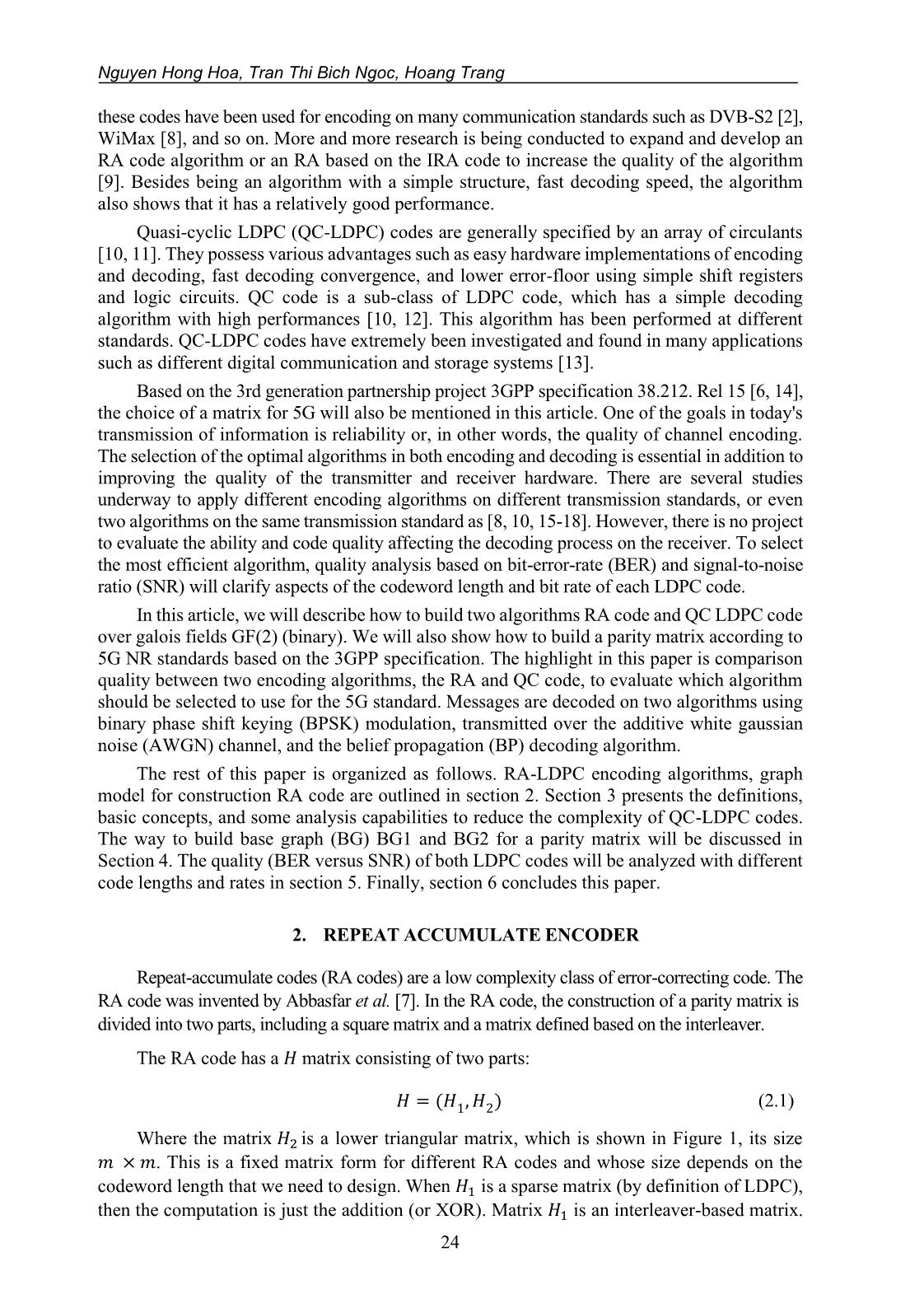
Trang 2
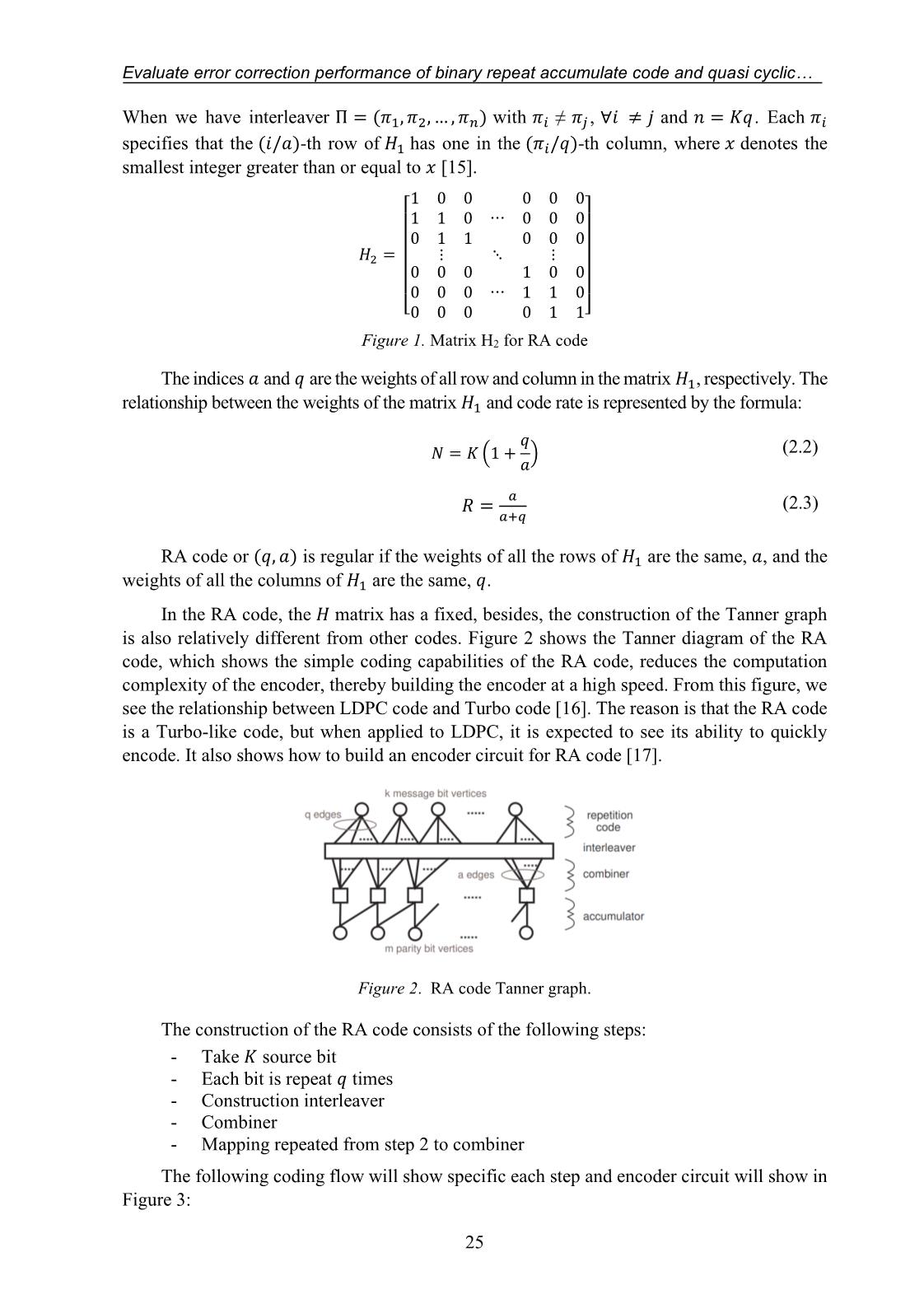
Trang 3
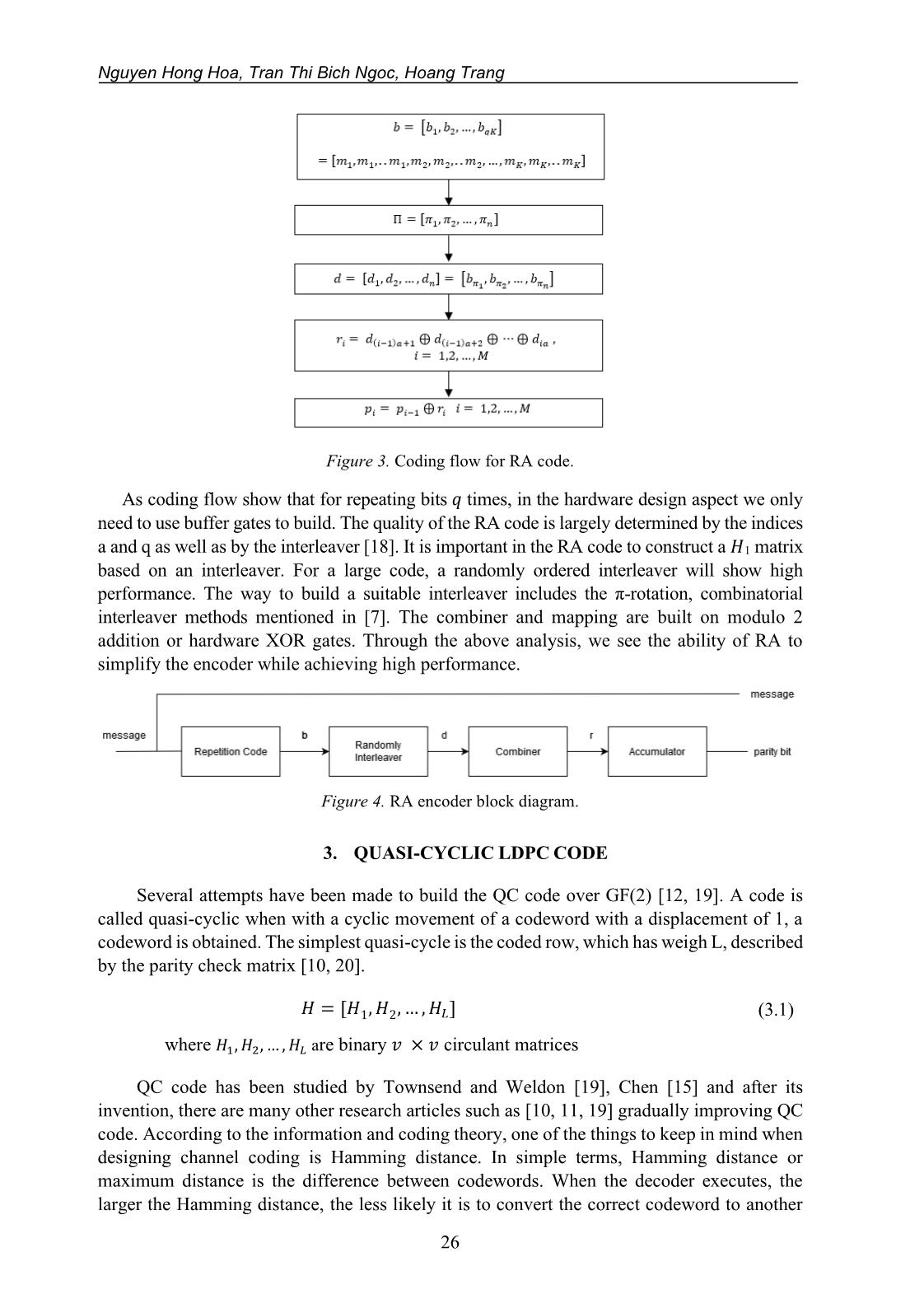
Trang 4
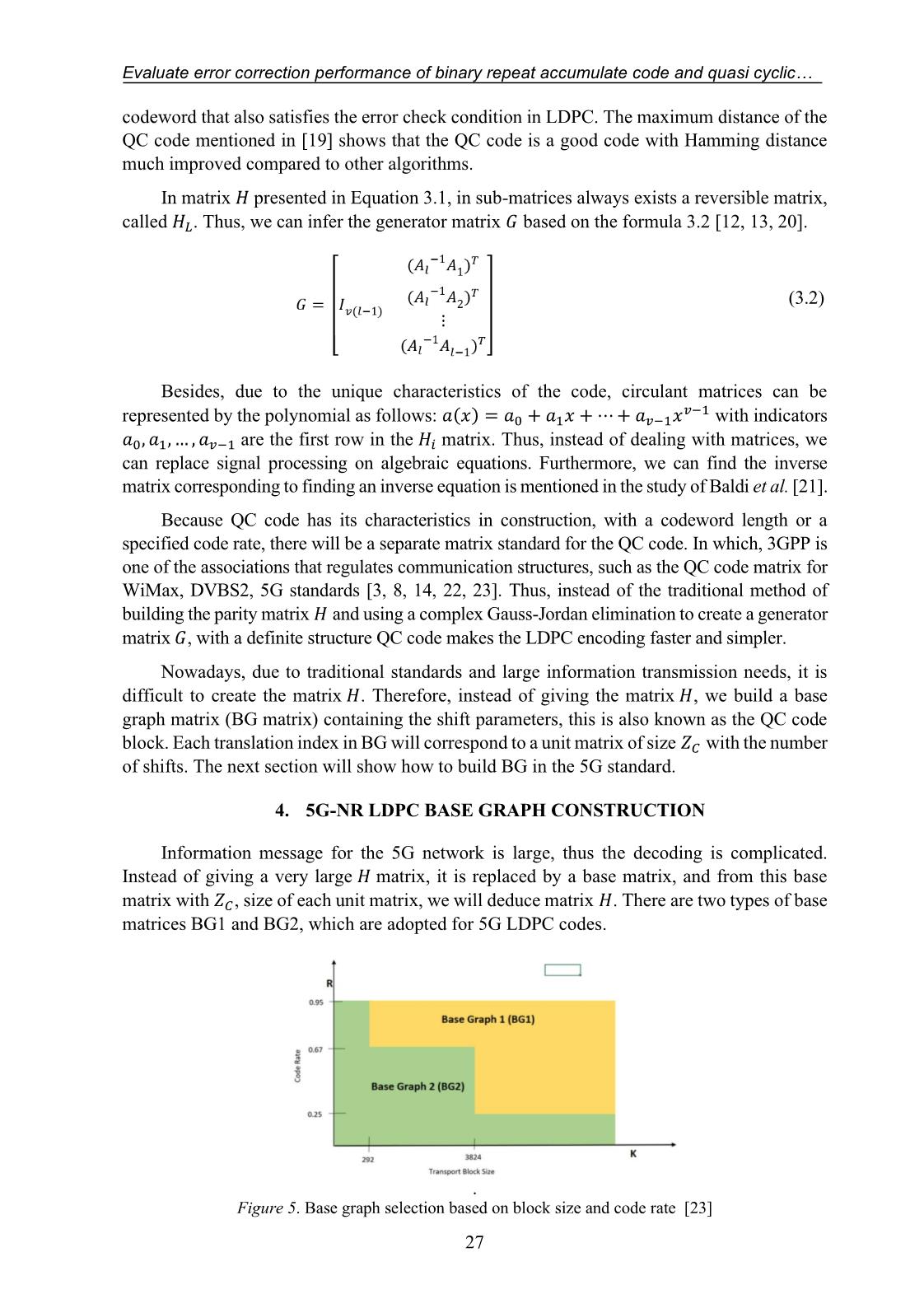
Trang 5
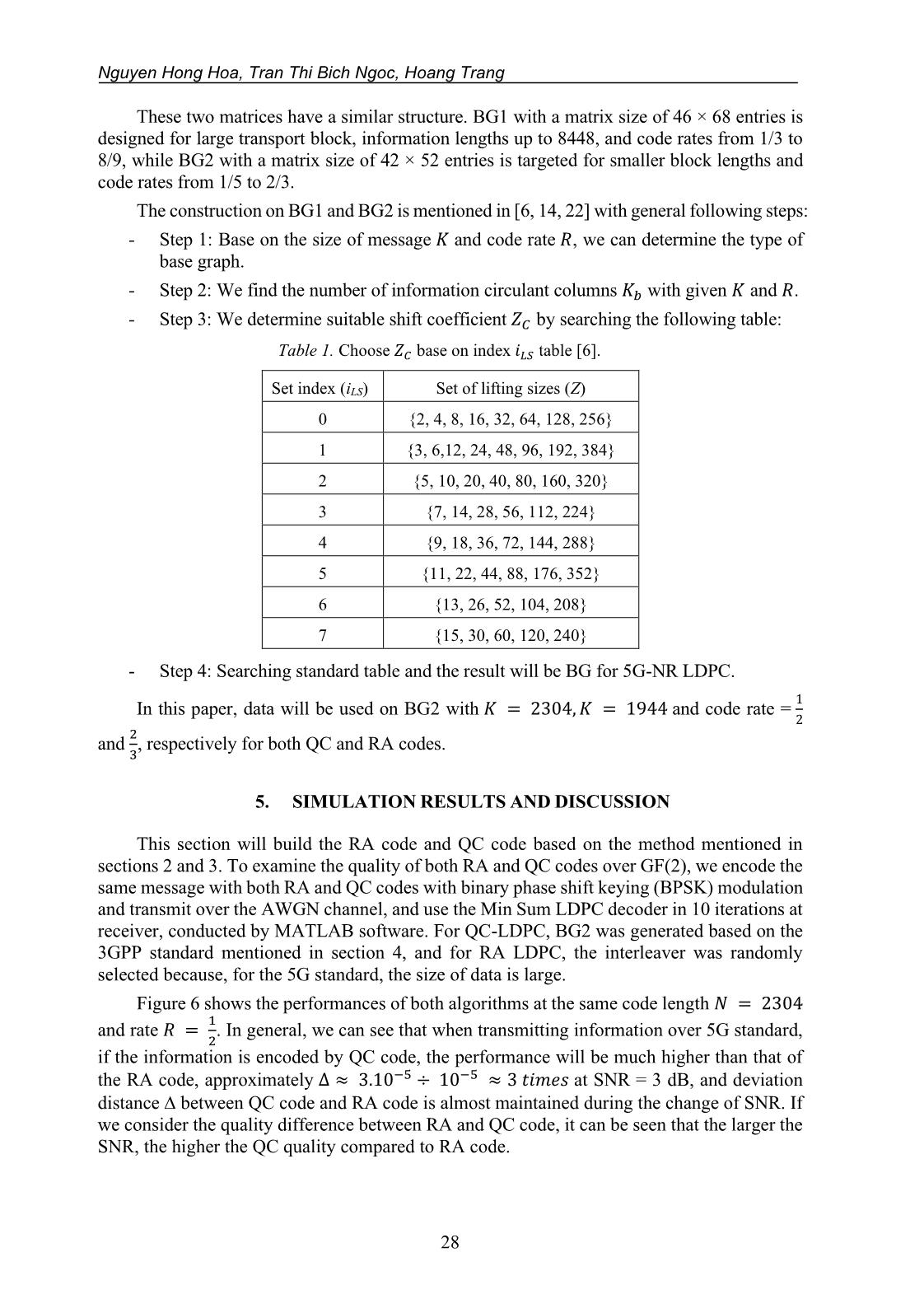
Trang 6
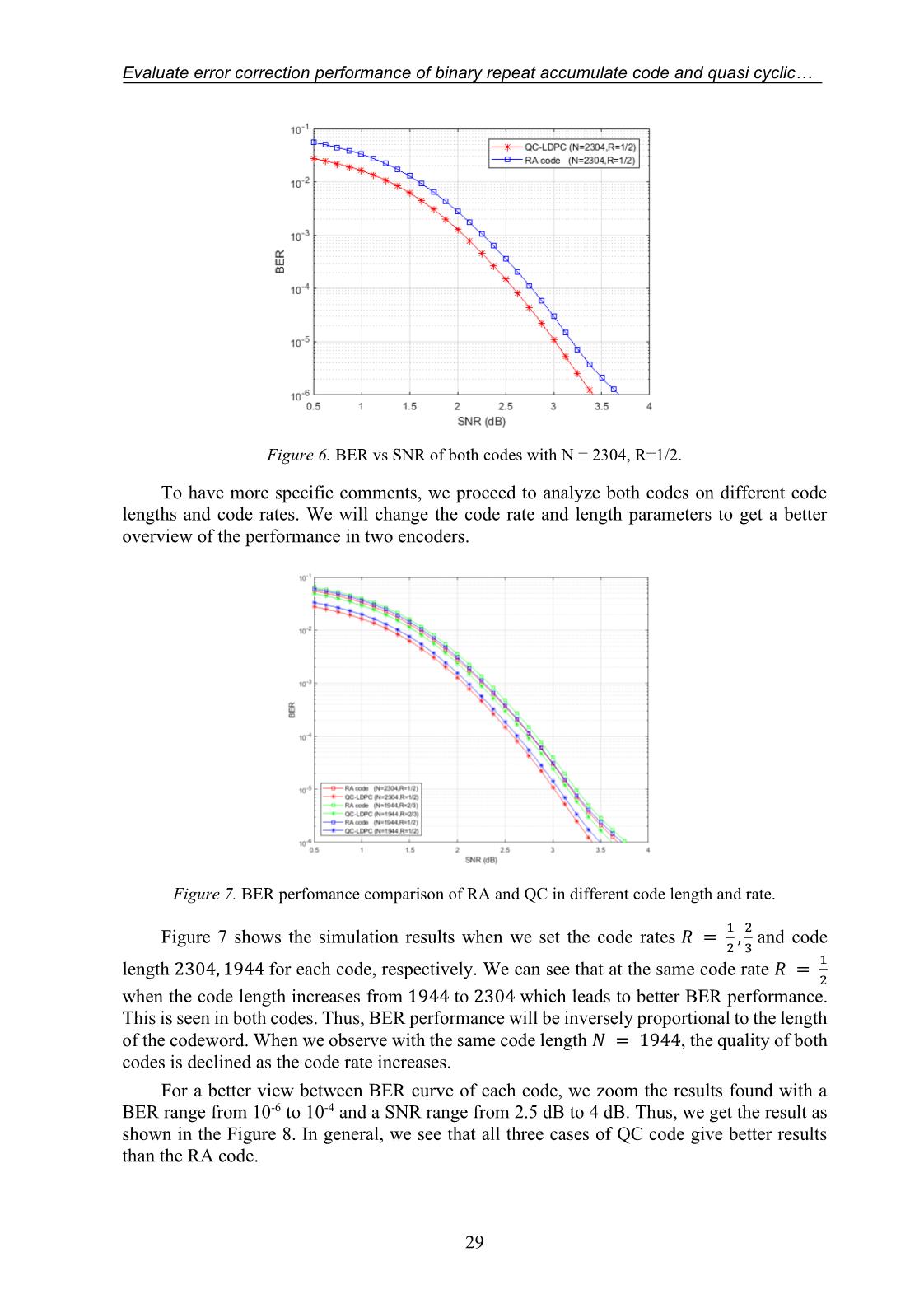
Trang 7
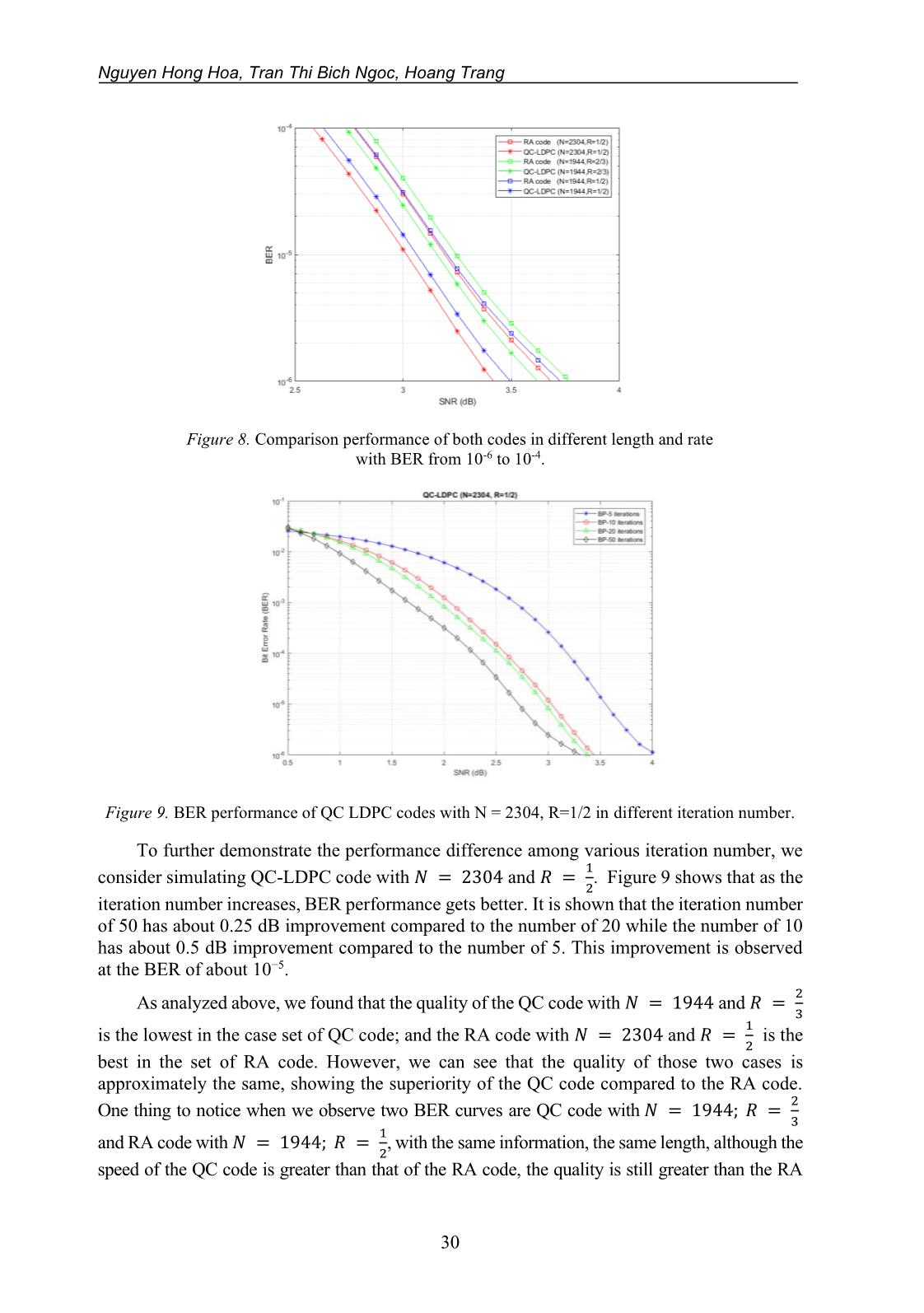
Trang 8
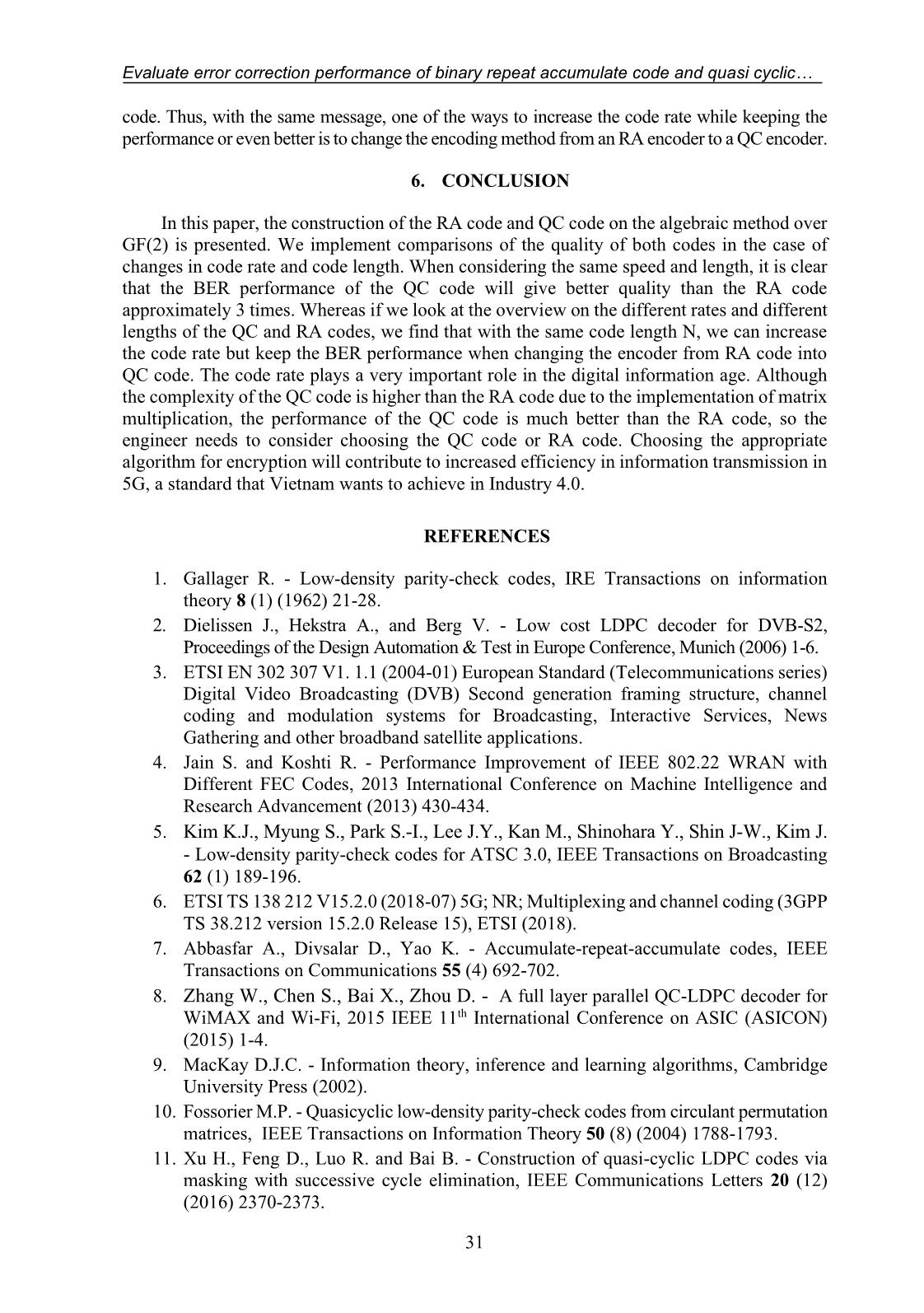
Trang 9
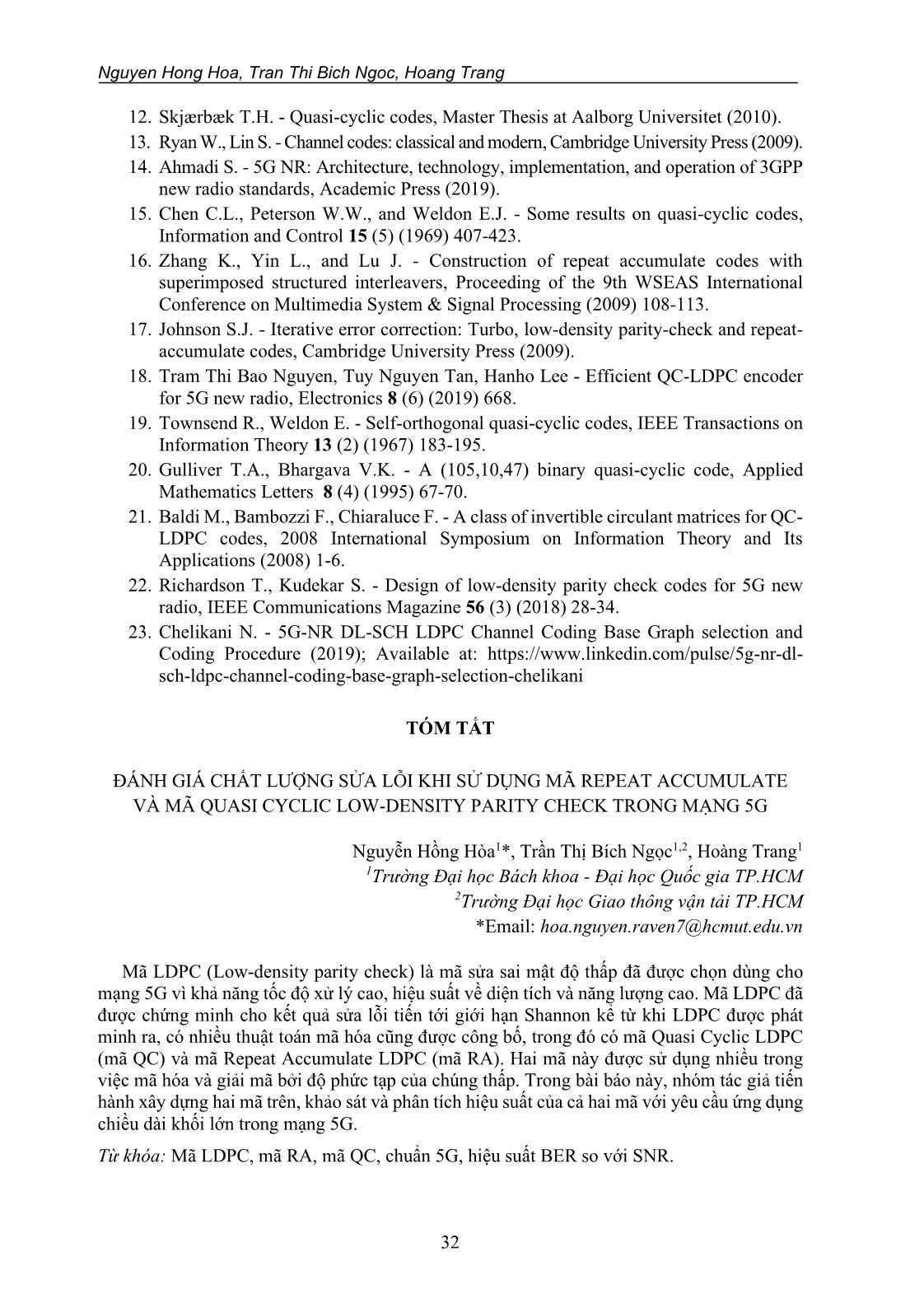
Trang 10
Tóm tắt nội dung tài liệu: Evaluate error correction performance of binary repeat accumulate code and Quasi cyclic low-density parity-check code in 5G new-radio

encoder block diagram.
3. QUASI-CYCLIC LDPC CODE
Several attempts have been made to build the QC code over GF(2) [12, 19]. A code is
called quasi-cyclic when with a cyclic movement of a codeword with a displacement of 1, a
codeword is obtained. The simplest quasi-cycle is the coded row, which has weigh L, described
by the parity check matrix [10, 20].
(3.1)
where 1, 2, , 퐿 are binary 푣 × 푣 circulant matrices
QC code has been studied by Townsend and Weldon [19], Chen [15] and after its
invention, there are many other research articles such as [10, 11, 19] gradually improving QC
code. According to the information and coding theory, one of the things to keep in mind when
designing channel coding is Hamming distance. In simple terms, Hamming distance or
maximum distance is the difference between codewords. When the decoder executes, the
larger the Hamming distance, the less likely it is to convert the correct codeword to another
26
Evaluate error correction performance of binary repeat accumulate code and quasi cyclic
codeword that also satisfies the error check condition in LDPC. The maximum distance of the
QC code mentioned in [19] shows that the QC code is a good code with Hamming distance
much improved compared to other algorithms.
In matrix presented in Equation 3.1, in sub-matrices always exists a reversible matrix,
called 퐿. Thus, we can infer the generator matrix based on the formula 3.2 [12, 13, 20].
(3.2)
Besides, due to the unique characteristics of the code, circulant matrices can be
푣−1
represented by the polynomial as follows: ( ) = 0 + 1 + ⋯ + 푣−1 with indicators
0, 1, , 푣−1 are the first row in the 푖 matrix. Thus, instead of dealing with matrices, we
can replace signal processing on algebraic equations. Furthermore, we can find the inverse
matrix corresponding to finding an inverse equation is mentioned in the study of Baldi et al. [21].
Because QC code has its characteristics in construction, with a codeword length or a
specified code rate, there will be a separate matrix standard for the QC code. In which, 3GPP is
one of the associations that regulates communication structures, such as the QC code matrix for
WiMax, DVBS2, 5G standards [3, 8, 14, 22, 23]. Thus, instead of the traditional method of
building the parity matrix and using a complex Gauss-Jordan elimination to create a generator
matrix , with a definite structure QC code makes the LDPC encoding faster and simpler.
Nowadays, due to traditional standards and large information transmission needs, it is
difficult to create the matrix . Therefore, instead of giving the matrix , we build a base
graph matrix (BG matrix) containing the shift parameters, this is also known as the QC code
block. Each translation index in BG will correspond to a unit matrix of size 푍 with the number
of shifts. The next section will show how to build BG in the 5G standard.
4. 5G-NR LDPC BASE GRAPH CONSTRUCTION
Information message for the 5G network is large, thus the decoding is complicated.
Instead of giving a very large matrix, it is replaced by a base matrix, and from this base
matrix with 푍 , size of each unit matrix, we will deduce matrix . There are two types of base
matrices BG1 and BG2, which are adopted for 5G LDPC codes.
.
Figure 5. Base graph selection based on block size and code rate [23]
27
Nguyen Hong Hoa, Tran Thi Bich Ngoc, Hoang Trang
These two matrices have a similar structure. BG1 with a matrix size of 46 × 68 entries is
designed for large transport block, information lengths up to 8448, and code rates from 1/3 to
8/9, while BG2 with a matrix size of 42 × 52 entries is targeted for smaller block lengths and
code rates from 1/5 to 2/3.
The construction on BG1 and BG2 is mentioned in [6, 14, 22] with general following steps:
- Step 1: Base on the size of message 퐾 and code rate 푅, we can determine the type of
base graph.
- Step 2: We find the number of information circulant columns 퐾 with given 퐾 and 푅.
- Step 3: We determine suitable shift coefficient 푍 by searching the following table:
Table 1. Choose 푍 base on index 푖퐿푆 table [6].
Set index (iLS) Set of lifting sizes (Z)
0 {2, 4, 8, 16, 32, 64, 128, 256}
1 {3, 6,12, 24, 48, 96, 192, 384}
2 {5, 10, 20, 40, 80, 160, 320}
3 {7, 14, 28, 56, 112, 224}
4 {9, 18, 36, 72, 144, 288}
5 {11, 22, 44, 88, 176, 352}
6 {13, 26, 52, 104, 208}
7 {15, 30, 60, 120, 240}
- Step 4: Searching standard table and the result will be BG for 5G-NR LDPC.
1
In this paper, data will be used on BG2 with 퐾 = 2304, 퐾 = 1944 and code rate =
2
2
and , respectively for both QC and RA codes.
3
5. SIMULATION RESULTS AND DISCUSSION
This section will build the RA code and QC code based on the method mentioned in
sections 2 and 3. To examine the quality of both RA and QC codes over GF(2), we encode the
same message with both RA and QC codes with binary phase shift keying (BPSK) modulation
and transmit over the AWGN channel, and use the Min Sum LDPC decoder in 10 iterations at
receiver, conducted by MATLAB software. For QC-LDPC, BG2 was generated based on the
3GPP standard mentioned in section 4, and for RA LDPC, the interleaver was randomly
selected because, for the 5G standard, the size of data is large.
Figure 6 shows the performances of both algorithms at the same code length = 2304
1
and rate 푅 = . In general, we can see that when transmitting information over 5G standard,
2
if the information is encoded by QC code, the performance will be much higher than that of
the RA code, approximately Δ ≈ 3.10−5 ÷ 10−5 ≈ 3 푡푖 푒푠 at SNR = 3 dB, and deviation
distance between QC code and RA code is almost maintained during the change of SNR. If
we consider the quality difference between RA and QC code, it can be seen that the larger the
SNR, the higher the QC quality compared to RA code.
28
Evaluate error correction performance of binary repeat accumulate code and quasi cyclic
Figure 6. BER vs SNR of both codes with N = 2304, R=1/2.
To have more specific comments, we proceed to analyze both codes on different code
lengths and code rates. We will change the code rate and length parameters to get a better
overview of the performance in two encoders.
Figure 7. BER perfomance comparison of RA and QC in different code length and rate.
1 2
Figure 7 shows the simulation results when we set the code rates 푅 = , and code
2 3
1
length 2304, 1944 for each code, respectively. We can see that at the same code rate 푅 =
2
when the code length increases from 1944 to 2304 which leads to better BER performance.
This is seen in both codes. Thus, BER performance will be inversely proportional to the length
of the codeword. When we observe with the same code length = 1944, the quality of both
codes is declined as the code rate increases.
For a better view between BER curve of each code, we zoom the results found with a
BER range from 10-6 to 10-4 and a SNR range from 2.5 dB to 4 dB. Thus, we get the result as
shown in the Figure 8. In general, we see that all three cases of QC code give better results
than the RA code.
29
Nguyen Hong Hoa, Tran Thi Bich Ngoc, Hoang Trang
Figure 8. Comparison performance of both codes in different length and rate
with BER from 10-6 to 10-4.
Figure 9. BER performance of QC LDPC codes with N = 2304, R=1/2 in different iteration number.
To further demonstrate the performance difference among various iteration number, we
1
consider simulating QC-LDPC code with = 2304 and 푅 = . Figure 9 shows that as the
2
iteration number increases, BER performance gets better. It is shown that the iteration number
of 50 has about 0.25 dB improvement compared to the number of 20 while the number of 10
has about 0.5 dB improvement compared to the number of 5. This improvement is observed
at the BER of about 10−5.
2
As analyzed above, we found that the quality of the QC code with = 1944 and 푅 =
3
1
is the lowest in the case set of QC code; and the RA code with = 2304 and 푅 = is the
2
best in the set of RA code. However, we can see that the quality of those two cases is
approximately the same, showing the superiority of the QC code compared to the RA code.
2
One thing to notice when we observe two BER curves are QC code with = 1944; 푅 =
3
1
and RA code with = 1944; 푅 = , with the same information, the same length, although the
2
speed of the QC code is greater than that of the RA code, the quality is still greater than the RA
30
Evaluate error correction performance of binary repeat accumulate code and quasi cyclic
code. Thus, with the same message, one of the ways to increase the code rate while keeping the
performance or even better is to change the encoding method from an RA encoder to a QC encoder.
6. CONCLUSION
In this paper, the construction of the RA code and QC code on the algebraic method over
GF(2) is presented. We implement comparisons of the quality of both codes in the case of
changes in code rate and code length. When considering the same speed and length, it is clear
that the BER performance of the QC code will give better quality than the RA code
approximately 3 times. Whereas if we look at the overview on the different rates and different
lengths of the QC and RA codes, we find that with the same code length N, we can increase
the code rate but keep the BER performance when changing the encoder from RA code into
QC code. The code rate plays a very important role in the digital information age. Although
the complexity of the QC code is higher than the RA code due to the implementation of matrix
multiplication, the performance of the QC code is much better than the RA code, so the
engineer needs to consider choosing the QC code or RA code. Choosing the appropriate
algorithm for encryption will contribute to increased efficiency in information transmission in
5G, a standard that Vietnam wants to achieve in Industry 4.0.
REFERENCES
1. Gallager R. - Low-density parity-check codes, IRE Transactions on information
theory 8 (1) (1962) 21-28.
2. Dielissen J., Hekstra A., and Berg V. - Low cost LDPC decoder for DVB-S2,
Proceedings of the Design Automation & Test in Europe Conference, Munich (2006) 1-6.
3. ETSI EN 302 307 V1. 1.1 (2004-01) European Standard (Telecommunications series)
Digital Video Broadcasting (DVB) Second generation framing structure, channel
coding and modulation systems for Broadcasting, Interactive Services, News
Gathering and other broadband satellite applications.
4. Jain S. and Koshti R. - Performance Improvement of IEEE 802.22 WRAN with
Different FEC Codes, 2013 International Conference on Machine Intelligence and
Research Advancement (2013) 430-434.
5. Kim K.J., Myung S., Park S.-I., Lee J.Y., Kan M., Shinohara Y., Shin J-W., Kim J.
- Low-density parity-check codes for ATSC 3.0, IEEE Transactions on Broadcasting
62 (1) 189-196.
6. ETSI TS 138 212 V15.2.0 (2018-07) 5G; NR; Multiplexing and channel coding (3GPP
TS 38.212 version 15.2.0 Release 15), ETSI (2018).
7. Abbasfar A., Divsalar D., Yao K. - Accumulate-repeat-accumulate codes, IEEE
Transactions on Communications 55 (4) 692-702.
8. Zhang W., Chen S., Bai X., Zhou D. - A full layer parallel QC-LDPC decoder for
WiMAX and Wi-Fi, 2015 IEEE 11th International Conference on ASIC (ASICON)
(2015) 1-4.
9. MacKay D.J.C. - Information theory, inference and learning algorithms, Cambridge
University Press (2002).
10. Fossorier M.P. - Quasicyclic low-density parity-check codes from circulant permutation
matrices, IEEE Transactions on Information Theory 50 (8) (2004) 1788-1793.
11. Xu H., Feng D., Luo R. and Bai B. - Construction of quasi-cyclic LDPC codes via
masking with successive cycle elimination, IEEE Communications Letters 20 (12)
(2016) 2370-2373.
31
Nguyen Hong Hoa, Tran Thi Bich Ngoc, Hoang Trang
12. Skjærbæk T.H. - Quasi-cyclic codes, Master Thesis at Aalborg Universitet (2010).
13. Ryan W., Lin S. - Channel codes: classical and modern, Cambridge University Press (2009).
14. Ahmadi S. - 5G NR: Architecture, technology, implementation, and operation of 3GPP
new radio standards, Academic Press (2019).
15. Chen C.L., Peterson W.W., and Weldon E.J. - Some results on quasi-cyclic codes,
Information and Control 15 (5) (1969) 407-423.
16. Zhang K., Yin L., and Lu J. - Construction of repeat accumulate codes with
superimposed structured interleavers, Proceeding of the 9th WSEAS International
Conference on Multimedia System & Signal Processing (2009) 108-113.
17. Johnson S.J. - Iterative error correction: Turbo, low-density parity-check and repeat-
accumulate codes, Cambridge University Press (2009).
18. Tram Thi Bao Nguyen, Tuy Nguyen Tan, Hanho Lee - Efficient QC-LDPC encoder
for 5G new radio, Electronics 8 (6) (2019) 668.
19. Townsend R., Weldon E. - Self-orthogonal quasi-cyclic codes, IEEE Transactions on
Information Theory 13 (2) (1967) 183-195.
20. Gulliver T.A., Bhargava V.K. - A (105,10,47) binary quasi-cyclic code, Applied
Mathematics Letters 8 (4) (1995) 67-70.
21. Baldi M., Bambozzi F., Chiaraluce F. - A class of invertible circulant matrices for QC-
LDPC codes, 2008 International Symposium on Information Theory and Its
Applications (2008) 1-6.
22. Richardson T., Kudekar S. - Design of low-density parity check codes for 5G new
radio, IEEE Communications Magazine 56 (3) (2018) 28-34.
23. Chelikani N. - 5G-NR DL-SCH LDPC Channel Coding Base Graph selection and
Coding Procedure (2019); Available at: https://www.linkedin.com/pulse/5g-nr-dl-
sch-ldpc-channel-coding-base-graph-selection-chelikani
TÓM TẮT
ĐÁNH GIÁ CHẤT LƯỢNG SỬA LỖI KHI SỬ DỤNG MÃ REPEAT ACCUMULATE
VÀ MÃ QUASI CYCLIC LOW-DENSITY PARITY CHECK TRONG MẠNG 5G
Nguyễn Hồng Hòa1*, Trần Thị Bích Ngọc1,2, Hoàng Trang1
1Trường Đại học Bách khoa - Đại học Quốc gia TP.HCM
2Trường Đại học Giao thông vận tải TP.HCM
*Email: hoa.nguyen.raven7@hcmut.edu.vn
Mã LDPC (Low-density parity check) là mã sửa sai mật độ thấp đã được chọn dùng cho
mạng 5G vì khả năng tốc độ xử lý cao, hiệu suất về diện tích và năng lượng cao. Mã LDPC đã
được chứng minh cho kết quả sửa lỗi tiến tới giới hạn Shannon kể từ khi LDPC được phát
minh ra, có nhiều thuật toán mã hóa cũng được công bố, trong đó có mã Quasi Cyclic LDPC
(mã QC) và mã Repeat Accumulate LDPC (mã RA). Hai mã này được sử dụng nhiều trong
việc mã hóa và giải mã bởi độ phức tạp của chúng thấp. Trong bài báo này, nhóm tác giả tiến
hành xây dựng hai mã trên, khảo sát và phân tích hiệu suất của cả hai mã với yêu cầu ứng dụng
chiều dài khối lớn trong mạng 5G.
Từ khóa: Mã LDPC, mã RA, mã QC, chuẩn 5G, hiệu suất BER so với SNR.
32 File đính kèm:
 evaluate_error_correction_performance_of_binary_repeat_accum.pdf
evaluate_error_correction_performance_of_binary_repeat_accum.pdf

